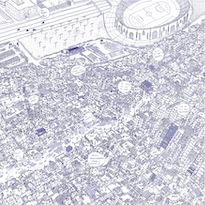Between camp and slum
Informal settlement as a major process for the survival of a displaced population in Sabra and Shatila.
Abstract
Immersed in a world where economic crises are intensifying, displaced populations, such as refugees and migrants, find themselves grappling with not only social inequalities and political conflicts but also the stark denial of their most fundamental rights. It is in camps and slums that many are forced to live in challenging conditions, making do with what is offered (and often not offered) on the fringes of our societies. These populations often enter an informal settlement process, where notions of survival, « home » and temporality overlap. Created in contexts of urgency and/or poverty, these so-called « relegation » or « transitory » spaces are established with the idea of accommodating individuals for a limited period. Fundamental questions arise regarding the evolution of these spaces and the stance an architect should take towards them. Focusing specifically on the Sabra and Shatila camp and slum (Fig.1), located on situated on the southern periphery of Beirut, Lebanon, this research addresses, through various scales (Fig.2.3.4.5), different aspects of these informal settlements, including the temporality of existing structures and future interventions proposed. Sabra and Shatila becomes a territory where preconceived ideas dissolve, and a new understanding is illuminated through the movement of populations, their cohabitation over time, and their territorial appropriations in space. Delving into an informal place like this is not a marginal challenge, as it constitutes the daily reality for over 1/7th of the global population. This work thus testifies to the challenges of daily life, the way of life of the inhabitants of Sabra and Shatila and raises awareness of how quickly a territory like this evolves. Transitioning from ephemeral structures to a lasting densification of the territory (Fig.5), everything is orchestrated and implemented by the inhabitants according to their desires and needs. Adopting construction and arrangement methods that are unique to them, these inhabitants improvise living spaces and informal systems to survive. The trace of an architect is therefore minimal, if not absent. The proposed interventions (Fig.7.8.9.10) do not aim to fix an idea in a specific time but rather to act punctually by providing a toolkit that allows inhabitants to modify a space according to their needs while providing social infrastructures (Fig.6). The goal is not to mimic a city frozen in time and erase all human aspects of these neighborhoods, but to enable every inhabitant to meet their basic needs and access a fundamental right: the right to the city.
Downloads

Downloads
Published
Versions
- 20.12.2023 (2)
- 18.12.2023 (1)
How to Cite
Issue
Section
License
Copyright (c) 2023 Laura Ghabris

This work is licensed under a Creative Commons Attribution 4.0 International License.
The authors keep their rights upon their work, although they transfer, in a non-exclusive way, the rights of exploitation (reproduction, publication, distribution, public dissemination and presentation) to the Journal. The authors are, therefore, free to enter additional, separate contracts for the non-exclusive distribution of the version of the work published in the Journal (for instance, by hosting in an institutional repository or publication in a book), provided credit is given that the work was initially published in this journal. The works are published under a Creative Commons Attribution 4.0 (CC BY 4.0) license.











